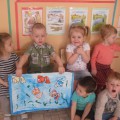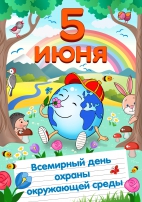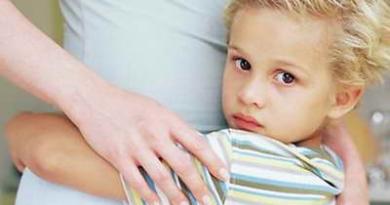Tatiana Krotova
"Hello, world!" The world around us for preschoolers of the younger group
Municipal budget preschool
"Sun"
« Hello, world!"
The world around us for preschoolers.
Subject: Pets.
Junior group.
Prepared:teacher
"Educators can only be those who can identify with a child's mental life, and we adults often do not understand children because we no longer understand our own childhood." This does not mean that children with children should come back with them, but we must learn to recognize the child that is in us.
“One of the main features of the unconscious is its connection with the infantile: that part of the personality which at that time was separate did not follow the evolution of the whole and was therefore removed.” Our reactions to different children and various types behaviors are determined by what they cause in us, and then we will have more or less problems, more or less repulsion or attraction, depending on whether the infant parts, periods or stages were caused, or more correctly, are part of the periods that somehow managed to bring us back to growth without removing them.
Krotova. T.A.
Pets.
Target: introduce to characteristic features appearance, behavior, lifestyle of pets; introduce a general concept "pet"; learn to recognize pets by description; develop visual perception, visual attention, visual memory, thinking; learn to correctly form nouns denoting cubs; develop the pitch of your voice; bring up careful attitude to animals.
Here are two thoughts. We conclude the discourse by referring to what Freud says about education: Psychoanalysis often has the opportunity to experience what part nervous system creates inadequate and unsurpassed educational serenity or at what cost of efficiency and pleasure normalcy is obtained is required. It can, however, teach what a precious contribution these perverted and perverted instincts of the child make to the formation of the character of the child, if they are not subjected to removal, but by a process of so-called sublimation they are distanced from their original purposes and directed towards greater ends.
Materials for joint educational activities:
Demonstration – images of a cat, dog, cow, horse. Images of a cat and a dog made from geometric shapes. Figurines of domestic animals and their babies.
Handout - a guide to familiarizing yourself with to those around world for children 3 - 4 years old, geometric shapes, pencils.
Our best virtues are based on relative formations and sublimations of our worst inclinations. Education must look scrupulously at the burial of these precious sources of energy and must limit itself only to encouraging the processes by which these energies can be channeled in a good manner.
We want children to have the opportunity to expand their horizons, meet and experience the world through music, art, theater, dance, sports and foreign language in addition to the program activities that each kindergarten. All classes are taught by passionate people, experts who expand their knowledge and pass on their passions to the children.
Progress of joint activities:
Draw the children's attention to the box that the guests brought.
Guys, look at the box. I wonder what's in it, do you know? And to open it we must solve riddles.
Milk for anyone?
Soft paws,
And there are scratches in the paws.
You stroke and caress,
You tease and he bites.
Who has a tail and a mane?
Frog-Shabinska. It takes into account the individuality of each child and allows you to develop aspects of your child's personality according to his or her intellectual predisposition, needs and pace. The core curriculum is taught daily. Kindergarten is an innovative educational cycle for preschool children based on the premise that entertainment is the main form of activity for a preschool child. The proposed activity is fun, because it is what helps the child learn about the world and learn in the way that is closest to him - imitate, test, look for solutions through trial and error, build.
Children name the answers, and the teacher displays pictures of the corresponding animals on a flannelgraph. Four legs and a tail should be clearly visible in these pictures.
How to call a cow, cat, dog, horse in one word? (pets)
Why were they called pets? What parts does an animal consist of? Why does a person keep them near him? Do pets need to be groomed? What should I do?
According to this theory, every child is potentially gifted and has several different types intelligence, among which one is dominant. It can be linguistic intelligence, logical-mathematical, visual-spatial, kinesthetic, musical, natural, interpersonal, intrapersonal. It is also possible that the child may have some dominant intelligence.
English with a teacher - daily, in each group English classes are held, conducted by the company "Languages for halving". Curricula are developed by a group of experienced teachers for each school year. Group teachers with skills English language Every day they repeat the problems from the morning lesson.
How many of you have a pet? Who is this? What's his name?
So, who are we going to talk about today? (about pets.)
Working with pictures.
Look at the picture with the children. Ask the children to find a tall, shaggy dog and a tall boy and give the dog a leash. (draw a line) boy. Then you need to find a small black dog and give it a leash. (draw a line) short girl.
Children's mathematics - daily didactic activities, enriching the core curriculum with additional mathematical problems. "Children's Mathematics" combines intensive intellectual development with the development of emotional immunity and mathematical skills. The most important thing in this education is personal experience child. These are the building blocks from which a child creates concepts and skills. The program is designed to enable a child to succeed in school while minimizing failure in mathematics learning.
After completing the task, talk to the children about how to behave if a dog approaches you on the street.
Physical education minute.
Hey, all the horses are following me! (hands forward, Let's hurry to the watering hole.
springy leg movements)
Here is a wide river, in it (smooth
Cold water, drink! raising hands,
forward bends)
Good water
The Children's Mathematics program is based on the following areas. Spatial orientation and social skills; Rhythm and rhythmic organization of time; Formation of counting skills, as well as addition and subtraction; Support the development of operational reasoning. Developing the ability to measure length; Classification; Organizing and solving arithmetic problems as a further improvement in children's accounting skills; Introducing children to the importance and importance of weighing; Measuring fluid and measuring meaning; Geometric intuition or the formation of geometric concepts; Construction of games by children; Saving mathematical operations with symbols.
Let's knock our hoof! (alternately
stamping with the left, then
right foot)
Hey, the horses are all behind me,
Let's gallop and go home. (clicking with the tip of the tongue)
Children sit at tables one at a time. Every child geometric set figures needed to lay out an image of a cat or dog. The teacher displays pictures.
Rhythm - in a children's chat led by Mrs. Basia, who also works daily at the Gdynia cultural center. During rhythm classes, children learn theme songs adapted to the current season or event, as well as elements of folk and integration dances. Classes develop rhythm and teach sensitivity to music. During the classes there are also rhythm and dance classes. Children also listen to short pieces of music from different genres, such as classical music, modern music, and children's songs.
During speech therapy we pay attention to correct pronunciation, we improve the functioning of the tongue, lips, cheeks. We study the correct pronunciation of individual sounds. We do different types of exercises and watch our performance in the mirrors. The classes allow you to catch up with children's pronunciation problems and parents are kept informed. Corrective gymnastics - led by Ms. Kasa - a specialist in her field. Children dress in sportswear and do exercises to prevent flatulence, posture and improve proper body attitude.
Each child, having looked at the drawings and his own set of figures, must guess who he can add up, and then do it.
After completing the task, you can ask the children to name the figures that make up this or that animal.
To perform next task children come to the table where there is a bag (it contains figurines of domestic animals and their cubs: cow-calf, dog - puppy, cat - kitten, pig - piglet, sheep - lamb).
We try to influence not only the motor skills of preschoolers, but also exercises that improve memory, concentration and attention. Dancing - once a week Polina conducts classes in modern and classical dance. The dance show takes place at events organized in the kindergarten.
An interesting world - physical and chemical experiments - is an annual series of scientific seminars. Classes are scenario based scientific experiments. The experiment is to stimulate the cognitive wavelength and develop the ability to carry out one's own research ideas. The child experiments, exploring the world.
Guys, do you know what's in this bag? Do you want to know? The teacher opens the bag, and each child takes turns taking one of the animal figurines in it. The teacher asks to name the animal they took (either adult or cub).
How does a little calf do this?
(The same goes for a dog and a puppy, a cat and a kitten, etc.) Children must pronounce onomatopoeia by changing the pitch of their voice.
Baikotherapy is a daily post-apocalyptic relaxation method and excellent therapy through stories designed to allow the child to explore the world around us, positive behavioral patterns and social sensitivity. Plastic - Most children love these activities so they are a regular part of every day. We work with different methods so children have the opportunity to try different methods doing your job. All works are displayed in the gallery in the lobby of the children's hut and then go into a children's folder.
Theater in kindergarten - once a month displayed in the children's chat room with professional actors with professional stage design and lighting. The ability to interact with art develops a child's imagination, allowing you to experience a unique experience that only real actors can deliver. Theater performances are a small celebration for us, which we always want to emphasize with the help of a suitable costume. During performances, we come to the kindergarten dressed elegantly, so that we learn that we need to dress beautifully to go to the theater or philharmonic.
At the end of the lesson, a poem by L. is read. Paramonova:
We consider those as pets
With whom I am in close contact we live:
Cows and horses, sheep and goats,
We shelter them warm from the frost.
We feed and water them, and if necessary, we give them a haircut.
We stroke them tenderly and always take care of them.
They are attached to us, very obedient
Excellent actors Leon Krzycki and Eugeniusz Sienkiewicz have been creating and performing wonderful children's shows for more than a decade. Musical concerts take place once a month and give us the opportunity to show children different faces music. Like theater performances, music concerts are professionally organized and our kindergarten turns into a wonderful philharmonic within a few hours. At concerts we also dress festively, showing respect for the artists and their art. During the concerts, children learn about different instruments, listen to interesting interpretations of famous works, but most of all play and explore the interesting world of classical music.
They give us milk and sour cream,
Others take us everywhere tirelessly,
And others guard our house,
They save food from mice.
Publications on the topic:
Today I want to offer you, dear colleagues, didactic game"Domestic and wild animals" allows you to consolidate the classification of animals.
Lesson summary “Pets” (second junior group) Purpose: – To consolidate children’s knowledge about domestic animals and their cubs and their cubs. – Reinforce knowledge about pet nutrition. – Activate.
Lesson summary “Pets” (junior group) PROGRESS OF THE CLASS. Program content: expansion and clarification of the dictionary on the topic “Pets and birds”, development fine motor skills through.
Summary of a lesson on speech development “Wild and Domestic Animals” (junior group) Purpose: clarification characteristic features appearance of animals, activation of relevant vocabulary; identification of common and distinctive features.
Summary of a lesson on speech development “Pets” (second junior group) Goal: consolidate knowledge about domestic animals. Tasks: -coherent speech: continue to teach about the teacher’s questions and write a description of the family.
GCD with integration of areas Topic: “Wild and domestic animals” OOD with integration of areas: " Speech development», « Cognitive development", "Social and communicative development", "Physical development".
GCD Topic: “Domestic animals and their young.” municipal budgetary preschool educational institution, compensatory kindergarten No. 65 “Kalinka”, Volzhsky, Volgograd region.
The world around us. "Dishes". First junior group The world around us. Educational activities: "Dishes" First junior group. Tasks: - To fix the names of the main utensils..
 Relevance of the topic: In modern urban conditions, not every family can afford to keep a pet in an apartment. The project allows.
Relevance of the topic: In modern urban conditions, not every family can afford to keep a pet in an apartment. The project allows.
Entertainment activity “Pets. Visiting Grandma Taya" (junior group)- Guys, say hello to the guests and send them your smiles. - Guys, look here, who do you see in front of you? (Children list animals).
Image library:

1. Observations of nature
Sky: clear, blue, gray, clouds in the sky.
Weather: rainy, stormy, sunny, windy, cloudy, foggy.
Rain: pouring, drizzling, knocking on the windows, trickles of water on the windows, puddles, downpour.
Wind: cold, trees sway, branches bend, leaves fly.
2. Meeting migratory birds
Some birds fly away to warmer regions, fly south, sparrows remain - they are not afraid of the cold.
Birds: crane, swallow, rook, swan, cuckoo, nightingale, starling, lark.
Dictionary: migratory, waterfowl, songbirds, arrival, nest, eggs, wintering, food, flock, wedge, feeder.
Exercises:
Affectionate name for birds: Nightingale - nightingale, crane - crane
Determine who is the odd one out: Nightingale, lark, crane, bullfinch.
3. Autumn - harvest
Repeat all the familiar vegetables again, tell the children about previously unknown fruits. If you have a personal plot or vegetable garden, collect the harvest with your children; if not, visit the market.
Games and activities:



